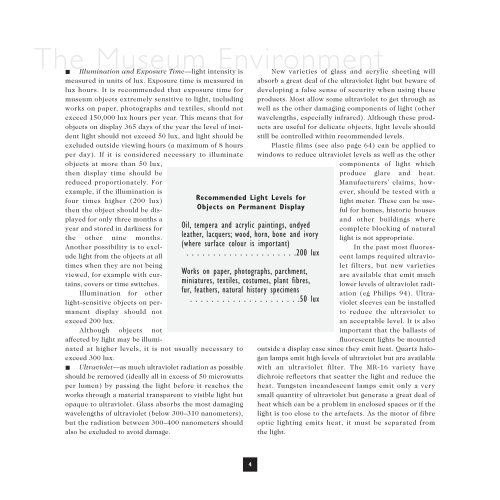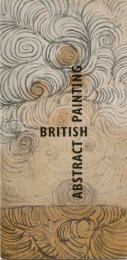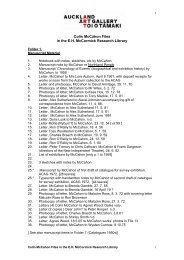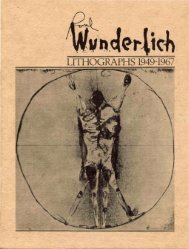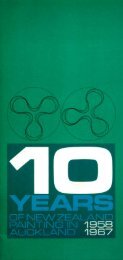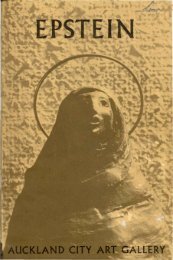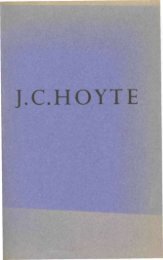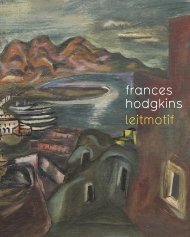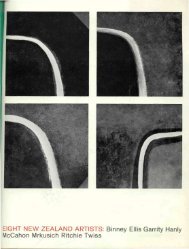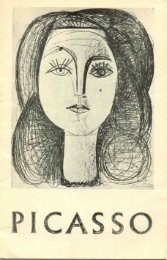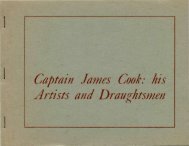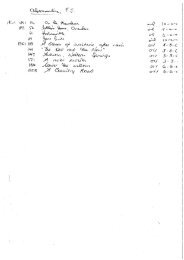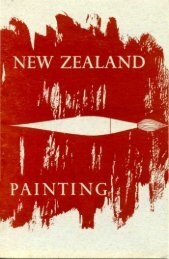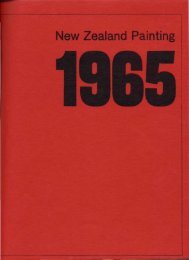example, if the illumination isfour times higher (200 lux)then the object should be displayedfor only three months ayear and stored in darkness forthe other nine months.Another possibility is to excludelight from the objects at alltimes when they are not beingviewed, for example with curtains,covers or time switches.Illumination for otherlight-sensitive objects on permanentdisplay should notexceed 200 lux.Although objects notaffected by light may be illuminatedat higher levels, it is not usually necessary toexceed 300 lux.Ultraviolet—as much ultraviolet radiation as possibleshould be removed (ideally all in excess of 50 microwattsper lumen) by passing the light before it reaches theworks through a material transparent to visible light butopaque to ultraviolet. Glass absorbs the most damagingwavelengths of ultraviolet (below 300–310 nanometers),but the radiation between 300–400 nanometers shouldalso be excluded to avoid damage.Recommended Light Levels forObjects on Permanent DisplayOil, tempera and acrylic paintings, undyedleather, lacquers; wood, horn, bone and ivory(where surface colour is important). . . . . . . . . . . . . . . . . . . . .200 luxWorks on paper, photographs, parchment,miniatures, textiles, costumes, plant fibres,fur, feathers, natural history specimens. . . . . . . . . . . . . . . . . . . . .50 luxThe Museum EnvironmentIllumination and Exposure Time—light intensity is New varieties of glass and acrylic sheeting willmeasured in units of lux. Exposure time is measured inlux hours. It is recommended that exposure time formuseum objects extremely sensitive to light, includingworks on paper, photographs and textiles, should notexceed 150,000 lux hours per year. This means that forobjects on display 365 days of the year the level of incidentlight should not exceed 50 lux, and light should beexcluded outside viewing hours (a maximum of 8 hoursper day). If it is considered necessary to illuminateobjects at more than 50 lux,absorb a great deal of the ultraviolet light but beware ofdeveloping a false sense of security when using theseproducts. Most allow some ultraviolet to get through aswell as the other damaging components of light (otherwavelengths, especially infrared). Although these productsare useful for delicate objects, light levels shouldstill be controlled within recommended levels.Plastic films (see also page 64) can be applied towindows to reduce ultraviolet levels as well as the othercomponents of light whichthen display time should beproduce glare and heat.reduced proportionately. ForManufacturers’ claims, however,should be tested with alight meter. These can be usefulfor homes, historic housesand other buildings wherecomplete blocking of naturallight is not appropriate.In the past most fluorescentlamps required ultravioletfilters, but new varietiesare available that emit muchlower levels of ultraviolet radiation(eg Philips 94). Ultravioletsleeves can be installedto reduce the ultraviolet toan acceptable level. It is alsoimportant that the ballasts offluorescent lights be mountedoutside a display case since they emit heat. Quartz halogenlamps emit high levels of ultraviolet but are availablewith an ultraviolet filter. The MR-16 variety havedichroic reflectors that scatter the light and reduce theheat. Tungsten incandescent lamps emit only a verysmall quantity of ultraviolet but generate a great deal ofheat which can be a problem in enclosed spaces or if thelight is too close to the artefacts. As the motor of fibreoptic lighting emits heat, it must be separated fromthe light.4
The Museum EnvironmentSunlight (because of its intensity and infrared radiationas well as ultraviolet) should neither be allowed tofall directly on to works of art nor be reflected on tothem from a mirrored surface. White paint (titanium,zinc and lead) is a fairly good ultraviolet absorber and,in some cases, it may be possible to solve the ultravioletproblem by ensuring that all light entering a room isreflected at least once from a white wall.Light Measurement—meters are available for measuringvisible light and ultraviolet radiation. All museumsshould either possess or have ready access to thesemeters.Air PollutionDust is damaging to museum objects. It makes themunsightly, can cause permanent soiling, and containsmicroscopic particles of grit which cut and abrade materials.It attracts water, encouraging chemical action andmould growth. Dust also contains substances such assalt which promote chemical degradation of materials.Smoking and the general use of aerosols should notbe permitted in display or storage areas because tobaccosmoke and aerosol substances form deposits on the surfaceof objects which are difficult or impossible toremove.Atmospheric pollution is also harmful to museumartefacts. Large cities tend to have high levels of carbonmonoxide and sulphur dioxide. Thermal areas producelarge amounts of hydrogen sulphide. Associated with highrelative humidity, these gases become destructive acids.Atmospheric pollutants can also be produced insidethe museum by the emission of gases from certain constructionmaterials, textiles, adhesives and paint, and inspecial cases from the artefacts themselves. It is advisableto check with a conservator before choosing materialsfor display or storage. For example, new concretewalls produce alkaline aerosol particles which can discolourdyes and pigments and weaken silk.The urea-formaldehyde foam used as thermal insulationand the formaldehyde resins used in plywood,particle board and other building materials produceformaldehyde gases which cause embrittlement and corrosionin many artefacts and are toxic to humans.Certain woods give off acetic, formic and tannic acidswhich can cause considerable damage to lead objects.Adhesives such as PVA emulsions have similar effects.Sulphides are emitted from certain rubbers, paintsand finished textiles causing the tarnishing of silver andthe discolouration of photographs and pigments.Cellulose nitrate preparations were among the firstplastics invented. They include photographic films, imitationsilk, adhesives, and impregnated fabrics. Cellulosenitrate continuously emits acidic vapours as it ageswhich can cause the disintegration of neighbouringobjects.Insects and MouldThese cause a significant amount of damage to NewZealand collections of cultural artefacts every year. Themild, humid climate found in many buildings which lackair conditioning provides a perfect environment for theirpropagation. The damage caused ranges from minorlosses and staining to virtual destruction. Organic materialsare affected most. Some common insect pests are:Silverfish (Thysanura: Lepismatidae)—feed mainlyon starchy substances but will eat many other materialsincluding cellulose, provided there is some starch contentpresent, eg paper, cardboard, cotton and linen.Clothes Moths (Lepidoptera: Tineidae)—adultclothes moths do not feed and it is the larvae whichcause the damage. The larvae will feed on almost anythingcontaining proteinaceous material and may damagealmost any other adjacent substance to reach it.Proteinaceous materials include animal products such ashair, horn, bone, claws, fur, wool, silk and feathers andthe exoskeletons of insects.Cockroaches (Orthoptera: Blattellidae/Blattidae)—will feed on a variety of materials, including books,leather, sizing and glues. Mainly, though, they are ‘food’eaters and damage materials through soiling.5


